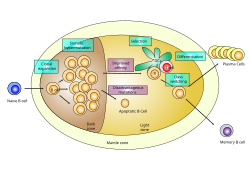This article needs additional citations for verification. (May 2016) |
| Germinal center | |
|---|---|
 Germinal center of a lymph node showing proliferation and development stages of a B cell. | |
| Identifiers | |
| MeSH | D018858 |
| Anatomical terminology | |
Germinal centers or germinal centres (GCs) are transiently formed structures within B cell zone (follicles) in secondary lymphoid organs – lymph nodes, ileal Peyer's patches, and the spleen[1] – where mature B cells are activated, proliferate, differentiate, and mutate their antibody genes (through somatic hypermutation aimed at achieving higher affinity) during a normal immune response; most of the germinal center B cells (BGC) are removed by tingible body macrophages.[2] There are several key differences between naive B cells and GC B cells, including level of proliferative activity, size, metabolic activity and energy production.[3] The B cells develop dynamically after the activation of follicular B cells by T-dependent antigen. The initiation of germinal center formation involves the interaction between B and T cells in the interfollicular area of the lymph node, CD40-CD40L ligation, NF-kB signaling and expression of IRF4 and BCL6.[4]
GC B cells cycle through the two distinct zones of the germinal center: the light zone and the dark zone.[3][4][5][6] As they undergo rapid and mutative cellular division, B cells of the germinal center's dark zone are known as centroblasts. Once these B cells have stopped proliferating in the dark zone and moved to the light zone, they are known as centrocytes, and are subjected to selection by follicular helper T (TFH) cells in the presence of follicular dendritic cells (FDCs).[3][4][5][6] There are three possible fates for GC B cells that have been positively selected in the light zone: plasma cell, memory B cell or B cell licensed to return to the dark zone for proliferation and mutation.[4][6] These three fates are achieved via the distinct mechanisms described below. Germinal centers are an important part of the B cell humoral immune response, acting as central factories for the generation of affinity matured B cells specialized in producing improved antibodies that effectively recognize antigen (e.g. infectious agents), and for the production of long-lived plasma cells and durable memory B cells.
- ^ Natkunam Y (1 January 2007). "The biology of the germinal center". Hematology. American Society of Hematology. Education Program. 2007: 210–215. doi:10.1182/asheducation-2007.1.210. PMID 18024632.
- ^ Aguzzi A, Kranich J, Krautler NJ (March 2014). "Follicular dendritic cells: origin, phenotype, and function in health and disease". Trends in Immunology. 35 (3): 105–113. doi:10.1016/j.it.2013.11.001. PMID 24315719.
- ^ a b c Victora, Gabriel D.; Nussenzweig, Michel C. (26 April 2022). "Germinal Centers". Annual Review of Immunology. 40 (1): 413–442. doi:10.1146/annurev-immunol-120419-022408. ISSN 0732-0582.
- ^ a b c d Kennedy, Domenick E.; Clark, Marcus R. (31 March 2021). "Compartments and Connections Within the Germinal Center". Frontiers in Immunology. 12. doi:10.3389/fimmu.2021.659151. ISSN 1664-3224. PMC 8045557. PMID 33868306.
- ^ a b Choi, Seung-Chul; Morel, Laurence (March 2020). "Immune metabolism regulation of the germinal center response". Experimental & Molecular Medicine. 52 (3): 348–355. doi:10.1038/s12276-020-0392-2. ISSN 2092-6413. PMC 7156389. PMID 32132626.
- ^ a b c Lau, Angelica WY; Brink, Robert (1 April 2020). "Selection in the germinal center". Current Opinion in Immunology. Lymphocyte development and activation. 63: 29–34. doi:10.1016/j.coi.2019.11.001. ISSN 0952-7915.